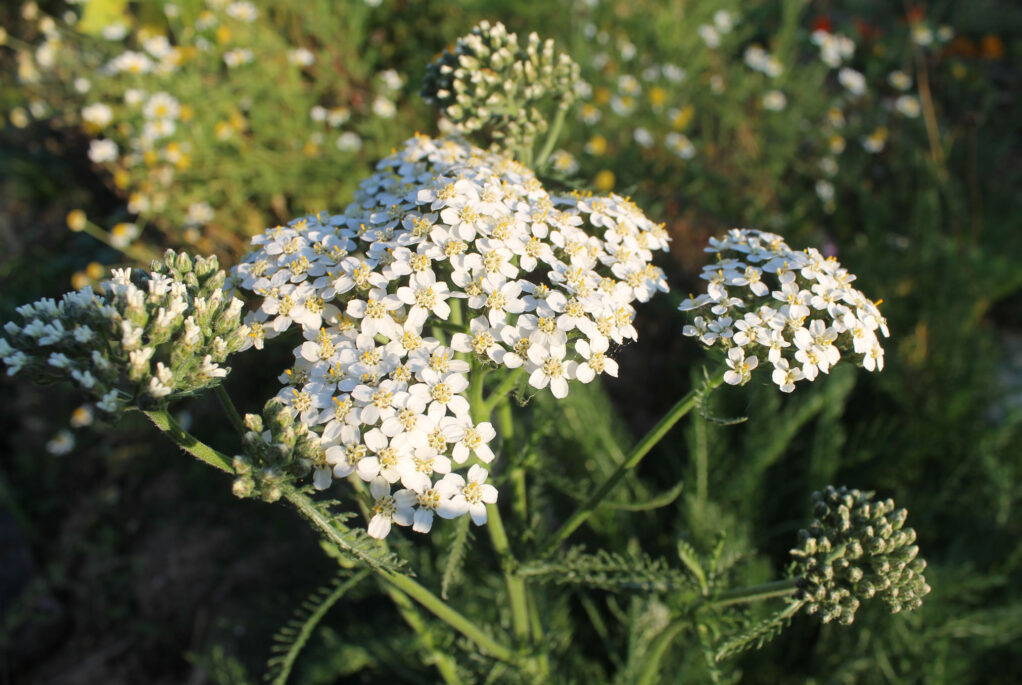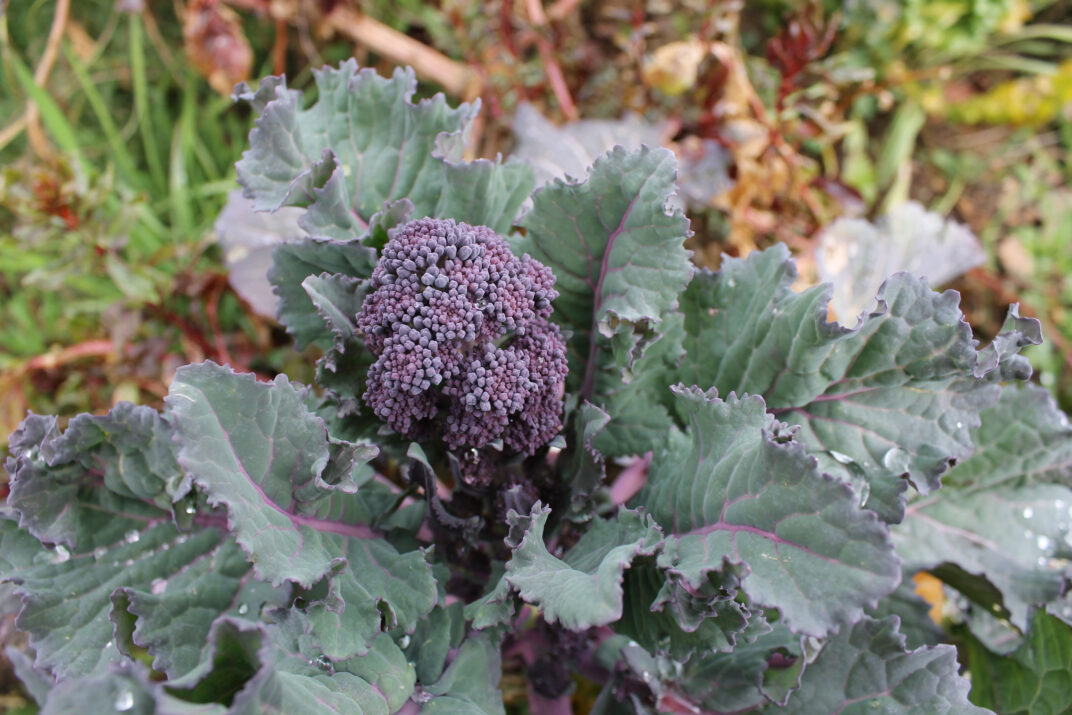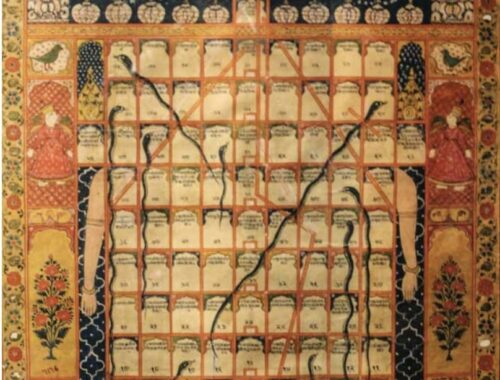
Yarrow: Chiron’s Arrow
Yarrow, Achillea millefolium is another one of my favourite helper plants (along with St John’s Wort, Melissa and Plantain). It grows wild here through spring and the long summer and I harvest the flowers and leaves and dry and store them for tea and wound healing powder, as well as making tinctures and sun oils for use throughout the year.
When I picked it, smelled it and crushed it in my fingers for the first time, it felt like a breath of fresh air. Yarrow has a lovely clean fragrance, gently floral and very slightly anti-septic (reminiscent of sticking plasters). Its scent is more pronounced in the leaves. I decided to pick some flowers and leaves, even though I didn’t know what I might use it for at the time – just following the trail of wondering.
Yarrow’s magical properties
With its lush feathery foliage tiny white flowers, floating like parasols in the breeze, you cannot doubt that it has a lot to offer. I have no hesitation in following my instincts. I get three clear indications when I question whether it is good for me to interact with a plant or substance:
- strong, clear ‘good for me’ with a feeling of eagerness and no hesitation or doubt, no mental chatter, my body just leaps joyfully towards whatever it is I’m asking about
- a hard ‘no way’ often coupled with a feeling of repulsion, sometimes I will ‘accidently’ drop the plant or substance
- nothing, no feeling at all. I’ve learned from experience that this also means that it’s not good for me at that time, even though I might want it to be!
Very often, the first thing I’ll do with a ‘good for me’ plant is make a tea. I’ve never liked herbal teas, they always taste stale and smell musty to me, but I like teas from plants I’ve harvested myself. My current favourites are, red clover, Queen Anne’s Lace, pennyroyal and yarrow.
Yarrow tea
Yarrow tea, made with leaves and flowers that have been dried for an hour or so (or up to a year if it has been stored out of sunlight) has an immediate normalising effect on body temperature and makes you slightly thirsty (the astringent effect). It is a bit bitter (as are many herbs/plants) and so I sweeten it with little honey.
When you follow your wondering, you are led into the unknown, out of the matrix and directly into Gaia’s dreaming. This can happen so gently that you might not realize what is going on, until you look back on it later. Yarrow tea, made with dried flowers, helps me slip into the trance-like state of awake dreaming very easily and that was the main attraction for me initially! One of its old names is Devil’s Plaything and a sure-fire way of identifying plants with psychotropic properties is to look for the devil in their folk lore names: Datura Stramonium, aka Devil’s Apple, Devil’s Trumpet; Belladona, aka Devil’s Cherries; Mandrake, Satan’s Apple and Devil’s Testicles. All these plants are known to have psychotropic properties, to be analgesic and have various other healing properties, as well as high levels of toxicity. In medieval times, anyone who practiced healing and enjoyed tripping was obviously a witch!
Yarrow for colds and chills
Yarrow tea is especially good for the kind of cold that comes from sudden exposure to cold weather. Our bodies aren’t made to adjust instantly to the climatic and microbial extremes we can experience through the wonders of air travel. This kind of cold comes with a clear, runny nose, sensitivity to cold temperatures and a bit of a headache and may be the start of a sore throat. It commonly occurs with the change of seasons, or when you travel to cold and wet Wales from sunny Ophiussa, as I experienced reecently. We tend to call it a head cold – wind with cold in Chinese medicine.
Yarrow tea is particularly good for this kind of cold, as it helps raise the body temperature to induce sweating. This may seem counter-intuitive with the sensitivity to cold, but sweating it out through the skin is the best approach for this type of cold, if you catch it quickly enough. (Saunas are also good.)
I made yarrow tea with ginger and went to bed, piling on four extra blankets and sweated it out. The cold was gone in a few days.
Intoxicating yarrow
Our ancestors were well-versed in the intoxicating effects of yarrow, especially when mixed with alcohol and it has been used in beer for thousands of years.
According to Stephen Harrod Buhner, author of Sacred Herbal and Healing Beers
“Odd Nordland explains:
The Fall of Gruit and the Rise of Brewer’s Droop
According to Linneaus, it [yarrow] was used by the people of Lima in Dalecarnia,instead of hops, when they brewed for weddings: ‘. . . so that the guests become crazy.’ Linneaus called the plant galentara, ‘causing madness’, and this plant ‘which the people of Lima sometimes use in their ale stirs up the blood and makes one lose one’s balance.’. . . Yarrow is in no way innocent when mixed with ale. It has a strong odour and flavour, and well deserves the name Linnaeus gave it, to indicate the frenzy that was said to result from it.”
Yarrow was among the plants buried alongside a Neanderthal man, plausibly a shaman or medicine man, in the Shanidar cave in Iraq over 60,000 years ago. Does this suggest that maybe the Neanderthals were not as primitive as we have been led to believe? Yarrow has been helping us for a very long time.
Healing with yarrow
The legend of yarrow is remembered in its botanical name: Achillea Millefolium. This roughly translates as ‘Achilles’ Plant of a Thousand Leaves’. Achilles is said to have used it to staunch his soldiers’ wounds on the battlefield and it also known as staunchweed.
The medicinal properties of yarrow have been well studied and are summarised in this article, Yarrow a Herbal Medicinal Plant with Broad Therapeutic Use
A few weeks ago, Izzy got a deep gash on her shoulder after an encounter in the woods, perhaps with a wild boar. I don’t know whether it gored her or whether she caught herself on a branch in the woods, but I put some iodine on it as soon as we got home from our walk. Iodine is very effective against bacteria, fungi and viruses and I use it to clean fresh wounds, as this is the best option for minimizing the risk of infection.
After I’d cleaned the wound, I saw that it was about 3cm long and a centimetre deep, pulling open because of the location on her shoulder. Dean thought it needed stitching, but it would have been next to impossible to get Izzy to the vets, so I packed the wound with dried yarrow powder. I did this twice a day for the next week or so as the wound dried out and scabbed over, then re-opened slightly because of her activity. Within three weeks it was completely healed, with no scarring.
Yarrow is styptic and hemostatic (stops bleeding), astringent (makes tissues contract), antiseptic (inhibits bacterial growth), vulnerary (helps tissues heal), anti-inflammatory, and slightly anesthetic. I use it powdered, dried in teas, in tinctures and salves. It is an essential element of the Gaian Medicine Cabinet.
It is one of those plants that seems to work in contradictory ways. It can staunch bleeding in a wound, but is also used to harmonize blood related issues, such as haemorrhaging or period pains.
According to Matthew Wood:
“Yarrow is both cooling and warming, fluid generating and controlling. remedies with contradictory but complementary properties are often of great utility since they are able to normalize opposing conditions. This is true for yarrow.”
The seeming contradictory healing powers of many plants are only because we look at disease through an allopathic lens, as a problem or a set of symptoms that call for a specific treatment. Actually, it is just an imbalance that plants are able to correct due to their innate intelligence and purposeful harmony.
When it comes to wounding, there comes a point when many wounded healers recognize their own pattern of self-harm and move on. Yarrow, in anyway you interact with it, helps you get to that point.
This poem, externalises the concept – the hole being the wound that yarrow helps you avoid by aiming its magical arrow beyond the immediate problem to the transcendent solution.
Ab Autobiography in Five Chapters, by Portia nelson
Chapter 1
I walk down the street.
There is a deep hole in the sidewalk.
I fall in. I am lost….I am helpless.
It isn’t my fault.
It takes forever to find a way out.
Chapter 2
I walk down the same street.
There is a deep hole in the side walk.
I pretend I don’t see it. I fall in again.
I can’t believe I am in the same place.
But it isn’t my fault.
It still takes a long time to get out.
Chapter 3
I walk down the same street.
There is a deep hole in the sidewalk.
I see it is there.
I fall in….it’s a habit…but my eyes are open.
I know where I am. It is my fault.
I get out immediately.
Chapter 4
I walk down the same street.
There is a deep hole in the sidewalk.
I walk around it.
Chapter 5
I walk down a different street.
Powdered yarrow: to stop bleeding and aid wound healing
Take 6-10 white flower heads. Dry the heads for 2-24 hours, depending on the weather. Grind the heads in a coffee mill and store in an airtight jar. It remains effective for a year or two if kept sealed and in the dark. It has a lovely fresh clean smell.
Use by applying directly to any bleeding wounds and it will stop the blood flow almost immediately and help the wound heal.
Open wounds need to be kept moist. When Freya got badly gashed by a boar and had a deep wound in the back of her thigh, we took her to the vets to get stitched up. She ripped out all the stitches in the night and I knew there was no point taking her back, so we used yarrow powder in coconut oil, so that it would stick to the wound and form a seal to keep it clean. It healed with only minimal scarring.

Yarrow tincture
Tincturing is a method for extracting the active ingredient from the plant, so that it can be used in liquid form and easily stored. Most tinctures will remain effective for at least a couple of years, if stored in a cool dark place. I add a teaspoonful to teas, when I don’t have the fresh or dried flowers.
I make yarrow tincture from fresh flowers at their peak and the top few leaves of the plant only. I pick what I need on a dry sunny morning (yarrow blooms from May to October here) and let the heads dry for an hour or so before using them, to let any critters get out of the way. I don’t wash the plants, because everything I use is wild and organic and it’s very clean here.
I use Orujo for tincturing, which is the local spirit distilled from the solids left after the grapes are pressed for wine. It is usually over 50% or 100˚ proof. We get ours from a neighbour, so I’m not sure how strong it is, but it seems to work well enough.
Yarrow flower essence
All healer plants work on multiple levels and flower essences, being subtler, work on the energetic rather than the physical levels. Yarrow is a wound healer, so the flower essence works to heal ‘wounds’ in the psyche and energy field or aura.
Flower essences work very well with dogs. We adopted Freya after Riley died. Freya had been found wandering the streets in a town in southern Spain. We don’t know anything about her previous life, but she was very skinny, covered in fleas and ticks and had lots of scars around her face and neck. She had obviously had a loving home before, because she is the cuddliest dog we’ve ever had, but she must have had to fight for her survival on the streets. She settled in immediately with Tulku (our male dog) but she and Izzy (our other female) were not quite sure of each other; they couldn’t work out the pecking order. Izzy is terribly sensitive and thought she had to take over Riley’s role, although that wasn’t what she wanted. Freya wasn’t taking any chances if Izzy came near her food and they both wanted to protect Tulku, who wanted nothing more than to play with them both at the same time.
I’ve been giving yarrow flower essence to all three a couple of times a day to help them with the transition into their new pack. Tulku didn’t need it, but he loves to take any kind of supplement or medication (seriously, he starts making sucking noises as soon as I get a dropper or syringe out). Izzy and Freya haven’t obviously bonded yet, but they can sleep on the same couch and the three of them all go off for a walk together often enough. It’s only been three weeks as I write this and they are becoming more comfortable with each other every day.
Yarrow insect repellent
There are many references on the internet to a US Army study that allegedly found a yarrow tincture insect repellent to be more effective than DEET. DEET is toxic stuff that no one should ever put on their skin – have you ever considered that your skin absorbs substances as easily as your gut? So why would you put anything on your skin that you would not consider eating?
The references to the unsubstantiated US Army study made me conduct my own study with yarrow tincture as an insect repellent. I didn’t do it it scientifically, I just diluted some yarrow tincture with water and sprayed it around. It smells lovely and does keep some flies out of the eating area, but it also has a cumulative effect; the more you use it the more it keeps bugs away. I haven’t tried it specifically for mosquitoes, but it is very useful generally.
(We use a home-made pyrethrum spray as a really effective bug, tick and flea killer. I don’t like to spray it around more often than necessary, because pyrethrum is also a neurotoxin, although it is much less harmful to mammals than insects and an organic substance is easier for the body to deal with than anything synthetic. Pyrethrin is generally used in reference to the synthesized version.)
Very little research is done on natural compounds, as it’s not sufficiently profitable, but I found this abstract of a study stating that yarrow has been shown to repel mosquitoes (I’m unable to link to the article now).
Abstract: An ethanol extract of Achillea millefolium L. showed repelling properties against the mosquito, Aedes aegypti L. Prepared fractions from the extract contained several active compounds which were characterized by thin layer chromatography, high performance liquid chromatography, gas chromatography and mass spectroscopy. Of 35 compounds tested, the most active were the nitrogen containing compound stachydrine, the carboxylic acids, caffeic, chlorogenic, and salicylic acids, and the phenolic compound pyrocatechol. These substances are earlier reported to occur in A. millefolium with the exception of pyrocatechol. Some further substances with lower activity were characterized for the first time in A. millefolium, i.e., adenine, ferulic and mandelic acid, and the methyl esters of caprylic-, linolenic- and undecylenic acid.
Yarrow as the gardener’s friend
In the compost heap
“Yarrow works in the compost heap in the same way as used medicinally in the human body: it can remedy the weaknesses of the astral (soul) body.”
Rudolf Steiner
We compost as much as possible, as a matter of choice and necessity. We don’t have any rubbish collection where we live and we don’t have a sewage system or septic tank – we have a compost loo. I’m very interested in anything that that helps the composting process.
This statement by Rudolf Steiner had me wondering why yarrow is identified as working in the compost heap in the same way as it does in the body, as opposed to any other healing plant. I did a bit more research and discovered that yarrow is known as a compost accelerant because of it’s ability to concentrate both sulphur and potassium, along with other micronutrients such as copper and phosphates.
I’ve started putting some dead yarrow heads, as well as the leftover plant matter from tincturing, in the compost pile and we’ll see how it goes.
Around the vegetable beds
In addition to helping the compost heap, I think that yarrow works in the earth in the same way as it does in the human body. It’s root runners help balance temperature in the topsoil, just as its tincture does in the blood. It spreads happily bringing lushness to the beds and is easily dug up when it’s time to replace it with something else.
Yarrow attracts beneficial insects and pollinators and is a great companion plant, because of its antibacterial and antifungal properties. It is considered to be of special benefit to aromatics, but I’ve put it all around the veggie beds and find that it generally makes everything grow stronger. It looks beautiful too!
As a natural fungicide
When I first discovered yarrow and began using it, I found a recipe for a fermented yarrow fungicide. I didn’t try it, as I didn’t need it at the time. Now I have a few trees and plants that have been suffering from various fungus attacks and I’d like to try it, but can’t find he recipe anywhere. If you can fond it, please let me know.
“Yarrow is always the greatest boon, wherever it grows wild in the country — at the edges of the fields or roads, where cereals or potatoes or any other crops are growing. It should on no account be weeded out… In a word, like sympathetic people in human society, who have a favourable influence by their mere presence and not by anything they say, so yarrow, in a district where it is plentiful, works beneficially by its mere presence.”
– Rudolf Steiner.

Broccoli Medicine
You May Also Like

Broccoli Medicine
March 8, 2020
Reality Checkers
December 11, 2024
